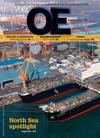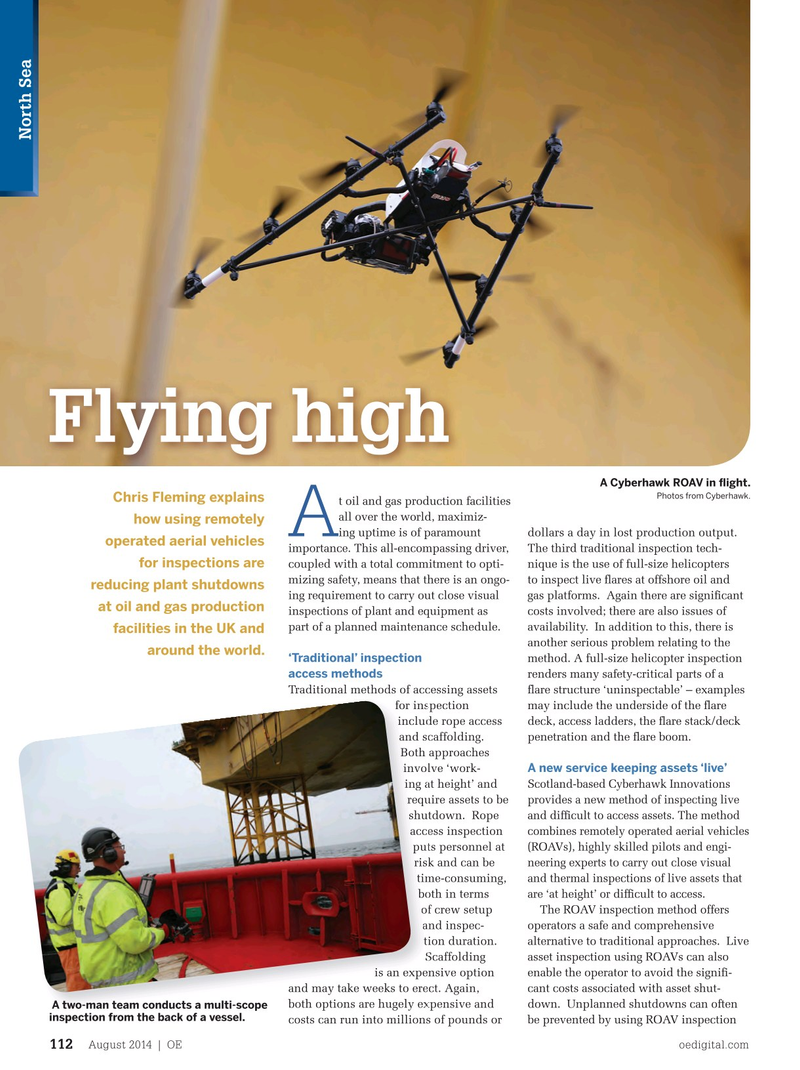
Page 110: of Offshore Engineer Magazine (Aug/Sep 2014)
Read this page in Pdf, Flash or Html5 edition of Aug/Sep 2014 Offshore Engineer Magazine
North Sea
Flying high
A Cyberhawk ROAV in ? ight.
Photos from Cyberhawk.
Chris Fleming explains t oil and gas production facilities all over the world, maximiz- how using remotely
A ing uptime is of paramount dollars a day in lost production output. operated aerial vehicles importance. This all-encompassing driver, The third traditional inspection tech- for inspections are coupled with a total commitment to opti- nique is the use of full-size helicopters mizing safety, means that there is an ongo- to inspect live ? ares at offshore oil and reducing plant shutdowns ing requirement to carry out close visual gas platforms. Again there are signi? cant at oil and gas production inspections of plant and equipment as costs involved; there are also issues of part of a planned maintenance schedule. availability. In addition to this, there is facilities in the UK and another serious problem relating to the around the world.
‘Traditional’ inspection method. A full-size helicopter inspection access methods renders many safety-critical parts of a
Traditional methods of accessing assets ? are structure ‘uninspectable’ – examples for inspection for inspection may include the underside of the ? are include rope access include rope access deck, access ladders, the ? are stack/deck and scaffolding. and scaffolding. penetration and the ? are boom.
Both approaches Both approaches
A new service keeping assets ‘live’ involve ‘work-involve ‘work-
Scotland-based Cyberhawk Innovations ing at height’ and ing at height’ and provides a new method of inspecting live require assets to be require assets to be and dif? cult to access assets. The method shutdown. Rope shutdown. Rope combines remotely operated aerial vehicles access inspection access inspection (ROAVs), highly skilled pilots and engi- puts personnel at puts personnel at neering experts to carry out close visual risk and can be risk and can be and thermal inspections of live assets that time-consuming, time-consuming, are ‘at height’ or dif? cult to access.
both in terms both in terms of crew setup of crew setup The ROAV inspection method offers and inspec- and inspec- operators a safe and comprehensive tion duration. tion duration. alternative to traditional approaches. Live
Scaffolding Scaffolding asset inspection using ROAVs can also is an expensive option is an expensive option enable the operator to avoid the signi? - and may take weeks to erect. Again, and may take weeks to erect. Again, cant costs associated with asset shut- both options are hugely expensive and both options are hugely expensive and down. Unplanned shutdowns can often
A two-man team conducts a multi-scope A two-man team conducts a multi-scope inspection from the back of a vessel.
costs can run into millions of pounds or be prevented by using ROAV inspection
August 2014 | OE oedigital.com 112 112_OE0814_Geofocus4_Cyberhawk.indd 112 7/22/14 3:47 PM

 109
109

 111
111